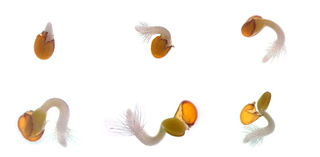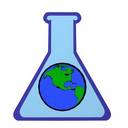Botany and Seed Germination Experiments

wikimedia.org/wiki/File:Different_stages_of_seed_germination(Arabidopsis_thaliana).jpg
6. The effects of light on seedling germination
How do light and dark conditions affect the germination and growth of seedlings?
Materials: 20 bean seeds, 2 Ziploc bags, 2 damp paper towels, desk lamp.
Procedure:
- Separate bean seeds into two different piles with equal number of seeds (10 seeds in each pile).
- Wet the paper towels until completely dampened. Place the dampened paper towels in the Ziploc bags, and then place 10 seeds on top of the paper towels in each bag. Make sure the seeds are on the paper towel in the bag and close the bag, but not completely (about 3/4 way closed).
- Wrap one of the Ziploc bags completely in aluminum foil. Leave the other one uncovered.
- Place both Ziploc bags under a desk lamp. After 7 days, check the bag that has been in the light as well as the bag that has been wrapped in aluminum foil. Compare the germinated seeds. You should definitely see a difference between the two. You should note mainly the color and stem length differences between the seedlings that germinated in light and those that germinated in darkness.
Results:What differences did you observe between seedlings that germinated in the light and in the dark? (color of leaves, length of stems, etc.) What caused those differences?
7. How do different treatments change how fast seeds sprout?
You can find out how quickly seeds sprout under different temperatures, or after being soaked for different times or in different liquids. Or, see how one kind of treatment affects different types of seeds.
Soil pH
8. How does soil pH affect the pH of water that touches the soil?
Procedure:
- Gather different types of soil. Put some of each type in a cup and check out the pH. (A pH meter can be found at almost any garden shop or nursery. )
- Then add water to the cups, and mix. Wait for the soil to settle and measure the pH of the water.
- Be sure you use water from the same source for each soil.
Background Info -the pH scale: Just about every substance is acidic, basic or neutral. The acid or base nature of a substance is measured by a pH scale that runs from 0 to 14. Substances from 0 to 7 are considered acid; substances from 7 to 14 are basic. Seven, the pH of pure water, is considered "neutral." The pH of your blood is about 7.35. Most plants grow best around pH 7.0. Some--like blueberries, azaleas and rhododendrons--like acid soil with a pH from about 5 to 6.
Protection from Insects
9. How close does a pesticide have to be to protect a plant?
Grow a number of groups of the same plant. Apply a Bt-based insecticide directly to the plant according to the directions on the package and at various distances from the plants. Compare the amount of insect damage to each group of plants. You might also look at how big or fast each group of plants grows.
10. Can different colors and types of cloth attract or repel insects from plants?
Plant a number of groups of the same type of plant near each other, but far enough apart to surround each set with several feet of fabric. Or select several of the same kind of bush in one yard. You want to use the same type of plant in the same place, so all of the plants will have the same potential for insect damage.
Surround each group of plants with a different color fabric. Be sure water can penetrate the fabrics.
At set intervals, record all the insects you can find on each plants and any signs of insect damage on the plant. It is a good idea to check reference sources for common insect problems of the type of plants you are using.
There are many references online that can help you identify the insects you find.
Plant Overcrowding
11. Does crowding affect plant growth?
How far apart should plants be placed? What happens when you overcrowd them....
See the rest of this experiment and many more on the next page.




